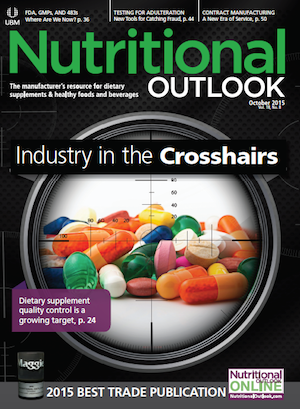U.S. Herbal Supplement Sales Up 6.8% in 2014
For the 11th year straight, herbal supplement sales were up, according to the annual HerbalGram report.
Photo © iStockphoto.com/ilyast

U.S. herbal supplement sales continued their 11-year upward streak in 2014, growing 6.8% in 2014 to reach $6.4 billion, according to Nutrition Business Journal (NBJ) estimates. The data is part of HerbalGram’s annual, comprehensive herbal supplements sales report, now published in the American Botanical Council (ABC; Austin, TX) journal.
Growth in the natural channel again outpaced growth in the mainstream market. In 2014, natural and health food retail sales (excluding Whole Foods Market) grew by 5.2% over 2013 to $330 million. But sales still grew mainstream, too, ticking up by 2.1% in 2014 over 2013 to reach between $802 million–$1.12 billion in food/drug/mass, military commissary, dollar, and club stores.
Herb Stars
Mainstream Channel
Leading the mainstream market’s bestsellers, the most popular ingredient in 2014 was again horehound (Marrubium vulgare), an ingredient popular for throat lozenges, with sales of nearly $106 million. The next bestsellers were cranberry (Vaccinium macrocarpon), echinacea (Echinacea spp.), black cohosh (Actaea racemosa), and flax or flaxseed oil (Linum usitatissimum).
“Ginkgo [Ginkgo biloba], garlic [Allium sativum], valerian [Valeriana officinalis], and milk thistle [Silybum marianum] ranked among the 20 top-selling herbs; total sales for these supplements were also some of the least changed from 2013 suggesting their continued mainstream acceptance,” states the HerbalGram report.
Some ingredients like ivy leaf (Hedera helix), rhodiola (Rhodiola spp.), guarana (Paullinia cupana), and wheat/barley grass (Triticum aestivum and Hordeum vulgare, respectively) made the top-40 list for the first time; by contrast, bromelain, artichoke, slippery elm, and acai each fell off the top-40 list in 2014.
Other notable mainstream standouts include coconut oil, which is “enjoying booming sales in the mainstream channel,” the report states, and double-digit growth for fenugreek, echinacea, elderberry, plant sterols, and turmeric.
The top-10 mainstream-channel sellers were:
- Horehound (Marrubium vulgare)
- Cranberry (Vaccinium macrocarpon)
- Echinacea (Echinacea spp.)
- Black cohosh (Actaea racemosa)
- Flax or flaxseed oil (Linum usitatissimum)
- Valerian (Valeriana officinalis)
- Yohimbe (Pausinystalia yohimbe)
- Bioflavonoid Complex
- Saw palmetto (Serenoa repens)
- Ginger (Zingiber officinale)
*View the HerbalGram article for a complete list of the top 40 sellers.
Natural Channel
In the natural channel, turmeric (Curcuma longa) again held the top spot in 2014 as it did in 2013, with almost 31% sales growth over 2013 up to $26 million. It was followed by wheatgrass and barley grass, flaxseed and/or flax oil, Aloe vera, and spirulina/blue-green algae (Arthrospira spp.). Growth did fall off for some ingredients, including stevia, but others saw notable gains in the natural channel, including maca (Lepidium meyenii) and oregano (Origanum vulgare).
The top-10 natural-channel sellers were:
- Turmeric (Curcuma longa)
- Wheatgrass and barley grass (Triticum aestivum and Hordeum vulgare, respectively)
- Flaxseed (Linum usitatissimum) and/or flax oil
- Aloe vera
- Spirulina/blue-green algae (Arthrospira spp.)
- Milk thistle (Silybum marianum)
- Elderberry (Sambucus nigra)
- Maca (Lepidium meyenii)
- Echinacea (Echinacea spp.)
- Oregano (Origanum vulgare)
*View the HerbalGram article for a complete list of the top 40 sellers.
And in the direct-sales channel, the report notes a 6.7% growth in 2014 over 2013, reaching nearly $200 million. The report also covers sales of single versus combination supplements, with gains reported for both types.
Relatively on Par with Years Past
The 6.8% overall herbal supplement sales growth in 2014 was not quite as high as growth in 2013, whose 7.9% growth marked the category’s highest rate of growth since the 1990s. But the upward trajectory still indicates that consumers are finding more value in herbal products. For instance, according to NBJ numbers, consumers have spent $1 billion more on these products since 2011 and $400 million more than they did since 2013.
“These figures suggest a clear trend: Americans are continuing to rely on botanical products for various aspects of their wellbeing and other personal needs,” the HerbalGram report reads.
The report also notes the ongoing investigation of herbal supplements led by New York Attorney General Eric Schneiderman started this year and addressed whether resulting negative press might impact impending 2015 herbal sales data. But the report points to a NutraIngredients-USA article indicating that SPINS data show that sales of herbal formula combination supplements in the year ending mid-July 2015 were actually up 12.6% compared to the year earlier, suggesting that negative press from the NY AG’s investigation has not hurt consumer sales.
“Consumers continue to demonstrate their interest and confidence in botanical dietary supplements for a wide variety of health reasons,” said Mark Blumenthal, founder and executive director of ABC and editor-in-chief of HerbalGram, in a press release discussing the new HerbalGram report.
ABC compiled the annual data together with Nutrition Business Journal and market researchers SPINS and IRI. Of note, the report covers herbal dietary supplements only and excludes sales of most herbal teas, botanicals for cosmetics, and herbals sold as over-the-counter medicines. Data does not reflect sales in Whole Foods Market or in convenience stores.
HerbalGram is available at some bookstores and natural food stores and is mailed to members of ABC. The annual HerbalGram herb market report article is posted on the ABC website, accessible here.
Jennifer Grebow
Editor-in-Chief
Nutritional Outlook magazine
jennifer.grebow@ubm.com

Prinova acquires Aplinova to further increase its footprint in Latin America
April 7th 2025Prinova has recently announced the acquisition of Brazilian ingredients distributor Aplinova, which is a provider of specialty ingredients for a range of market segments that include food, beverage, supplements, and personal care.
























